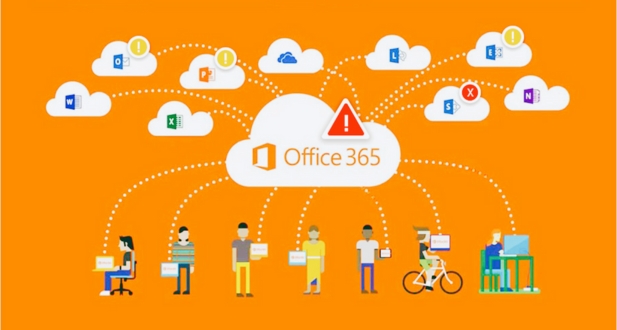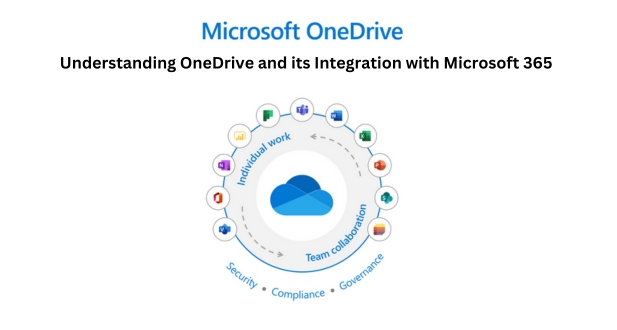Introduction:
The advent of cloud computing has transformed the way businesses operate, enabling them to store, manage, and collaborate on data in ways that were once inconceivable. Microsoft 365, previously known as Office 365, has been at the forefront of this transformation, providing a suite of applications that enhance productivity, communication, and collaboration. OneDrive, an integral part of Microsoft 365, serves as a cornerstone for cloud storage, offering a secure and scalable solution for businesses of all sizes.
Understanding OneDrive and its Integration with Microsoft 365
Overview of OneDrive:
OneDrive stands as a prominent cloud storage solution developed by Microsoft. Initially conceived as a personal storage platform, it has evolved into a comprehensive enterprise-grade collaboration tool. Users can store files and documents securely in the cloud, accessible from any device with an internet connection. OneDrive offers features like file versioning, real-time collaboration, and synchronization across devices, making it a versatile solution for individuals and businesses alike.
OneDrive’s evolution into an enterprise-grade tool represents a paradigm shift in how organizations manage and collaborate on documents. The platform transcends traditional file storage, becoming an integral part of digital workflow and fostering collaboration in real time. As businesses increasingly embrace remote work and flexible collaboration, OneDrive emerges as a vital component in ensuring seamless access to files and data.
Microsoft 365 Integration:
OneDrive seamlessly integrates with the Microsoft 365 suite, enhancing its functionality and providing users with a cohesive digital ecosystem. The integration with Microsoft 365 applications, including Word, Excel, PowerPoint, and others, is a key feature. Users can create, edit, and collaborate on documents directly within the OneDrive environment, promoting a unified and streamlined workflow.
Collaboration possibilities within OneDrive extend to real-time co-authoring, allowing multiple users to work on the same document simultaneously. This functionality significantly improves efficiency and teamwork, as changes are instantly reflected across all connected devices. Whether it’s a team working on a presentation or individuals collaborating on a report, OneDrive facilitates a dynamic and synchronized work environment.
The integration with Microsoft 365 ensures that files stored in OneDrive are seamlessly accessible within other Microsoft 365 applications. This interoperability simplifies document management and enhances productivity by breaking down silos between different tools. Users can transition seamlessly between OneDrive and other Microsoft 365 applications, creating a cohesive experience that boosts efficiency and collaboration across the entire platform.
Features and Functionality of OneDrive
File Storage and Organization:
OneDrive offers a robust set of features for efficient file storage and organization. Users can easily upload and download files, fostering a seamless flow of data between devices. The platform provides a user-friendly interface that simplifies the process of organizing files, allowing users to create folders, categorize documents, and establish a logical file structure.
One notable aspect of the file management capabilities is the version history feature. Users can track changes made to documents over time, enabling easy recovery of previous versions. This ensures that accidental modifications or deletions can be reversed, providing a safety net for users to maintain the integrity of their files.
Real-time Collaboration:
OneDrive excels in fostering real-time collaboration among users. The platform supports simultaneous editing, allowing multiple users to work on the same document concurrently. This feature enhances teamwork and accelerates project completion by eliminating the need for file transfers or constant synchronization.
Moreover, co-authoring features take collaboration to the next level. Users can collaborate on documents seamlessly, with changes reflected instantly for all collaborators. This not only improves productivity but also ensures that everyone is working on the most up-to-date version of the document, promoting accuracy and efficiency in collaborative projects.
Security and Compliance:
OneDrive prioritizes security and compliance, making it a reliable platform for safeguarding sensitive data. The implementation of end-to-end encryption ensures that files are secure during transmission and storage. This robust encryption mechanism adds an extra layer of protection, reducing the risk of unauthorized access or data breaches.
In addition to encryption, OneDrive adheres to industry standards and regulations, ensuring compliance with data protection and privacy requirements. This is particularly crucial for businesses and organizations dealing with sensitive information, as it helps them meet legal and regulatory obligations. OneDrive’s commitment to security and compliance instills confidence in users, making it a trustworthy solution for handling confidential data.
Business Benefits of OneDrive:
Cost Efficiency:
OneDrive offers significant cost advantages over traditional on-premises storage solutions. By leveraging cloud storage, organizations can avoid the upfront costs associated with hardware, maintenance, and physical space. The scalability of OneDrive allows businesses to pay for the storage they need, making it a cost-effective solution for organizations of all sizes. The pay-as-you-go model ensures that businesses only pay for the resources they consume, leading to potential cost savings.
Remote Work and Flexibility:
OneDrive plays a pivotal role in supporting remote work and providing flexibility to employees. With cloud-based access, employees can securely access their files from anywhere with an internet connection. Mobile applications and cross-platform compatibility further enhance flexibility, enabling users to collaborate and work seamlessly across various devices. This flexibility not only improves employee satisfaction but also contributes to increased productivity and responsiveness to changing work environments.
Enhanced Productivity:
Integration with Microsoft 365 apps makes OneDrive a powerful tool for enhancing productivity. Users can seamlessly collaborate on documents using familiar applications like Word, Excel, and PowerPoint. The integration with artificial intelligence (AI) features introduces intelligent content suggestions, making it easier for users to find relevant files and information. These AI-driven capabilities not only save time but also contribute to a more efficient and streamlined workflow, ultimately boosting overall productivity within the organization.
Best Practices for OneDrive Implementation
User Training and Adoption:
User training is a critical component of a successful OneDrive implementation. While the platform offers numerous features for file storage, sharing, and collaboration, its effectiveness relies heavily on users’ ability to navigate and leverage these functionalities. Providing comprehensive training sessions ensures that employees understand how to use OneDrive to its fullest potential, increasing overall productivity and efficiency within the organization.
Fostering user adoption is equally essential for realizing the benefits of OneDrive. Strategies for encouraging adoption include creating awareness about the platform’s advantages, emphasizing its user-friendly interface, and highlighting how it streamlines collaborative work. By demonstrating the value OneDrive adds to daily tasks and workflows, organizations can motivate users to embrace the platform, ultimately driving successful implementation.
Data Governance and Compliance:
Implementing robust data governance policies is imperative to maintain control and security over the organization’s information. With OneDrive serving as a central repository for files, clear governance policies help define access levels, permissions, and data sharing protocols. This not only protects sensitive information but also ensures that data is organized and accessible to authorized individuals.
Ensuring compliance with data protection regulations is another critical aspect of OneDrive implementation. Organizations must align their usage of OneDrive with relevant laws and industry standards governing data privacy and security. By integrating compliance measures into the implementation plan, such as encryption and access controls, organizations can mitigate the risk of regulatory violations and safeguard sensitive data.
Backup and Disaster Recovery:
Regular backups of critical business data stored in OneDrive are fundamental to minimizing data loss and ensuring business continuity. Organizations should establish automated backup routines that capture changes in real-time, reducing the risk of data loss due to unforeseen events such as system failures, human errors, or cyberattacks.
Disaster recovery planning and implementation are crucial for mitigating the impact of catastrophic events. This involves developing comprehensive strategies to restore data and functionality swiftly in the aftermath of disasters. By having a well-defined disaster recovery plan, organizations can minimize downtime, maintain customer trust, and resume normal operations efficiently. This includes considerations such as data redundancy, off-site backups, and a step-by-step recovery process that aligns with the organization’s specific needs and priorities.
OneDrive in Action
Setting Up OneDrive for Business:
Setting up OneDrive for Business is a seamless process that begins with users logging in using their Microsoft 365 credentials. Once logged in, individuals gain access to a user-friendly interface, ensuring a smooth onboarding experience. The simplicity of the setup contributes to a quick start, allowing users to engage with the platform effortlessly.
File Management and Organization:
OneDrive empowers users with a robust file management system that aligns with diverse workflow requirements. Users can easily create folders, move files, or make copies, fostering a flexible organizational structure. This adaptability ensures that files are systematically arranged, enabling users to locate and work with their documents efficiently.
Real-time Collaboration:
OneDrive’s true strength emerges when multiple users collaborate on a document in real-time. Whether it’s a collaborative project or a presentation being edited by colleagues, the platform’s real-time collaboration features eliminate the need for multiple document versions. This not only streamlines the editing process but also enhances team productivity by fostering seamless collaboration.
Integration with Microsoft 365 Apps:
The integration of OneDrive with Microsoft 365 applications significantly enhances user workflows. Users can directly open and edit documents from Word, Excel, or PowerPoint, with automatic saving to OneDrive. This integration minimizes friction associated with file management, providing a cohesive user experience across the Microsoft 365 ecosystem.
Version Control and Recovery:
OneDrive addresses a critical aspect of document management through robust version control. The platform keeps a comprehensive record of changes, allowing users to review and restore previous versions of a file. This feature serves as both a safety net for potential mistakes and an enabler for a collaborative environment where experimentation is encouraged. Version control in OneDrive promotes a secure and adaptable approach to document collaboration.
Enhancing Productivity with OneDrive
OneDrive, Microsoft’s cloud storage solution, offers a range of features aimed at enhancing productivity in today’s dynamic work environments.
Anywhere, Anytime Access:
One of the key advantages of OneDrive is its cloud-based architecture, enabling users to access their files from anywhere with an internet connection. This flexibility is particularly valuable for businesses that have embraced remote work or for individuals who need to retrieve important documents while on the move.
Mobile Accessibility:
To cater to the increasingly mobile nature of work, OneDrive provides a dedicated mobile app compatible with both iOS and Android devices. This app empowers users to not only view but also edit and share files, ensuring productivity on smartphones and tablets, irrespective of the operating system.
Offline Access:
Recognizing that a stable internet connection isn’t always guaranteed, OneDrive allows users to access selected files offline. This feature ensures uninterrupted workflow, enabling individuals to work on important documents even when connectivity is unreliable. Any changes made offline are automatically synchronized when an internet connection is re-established.
Collaboration Beyond Boundaries:
OneDrive facilitates seamless collaboration not only within organizational confines but also extends its reach beyond. External collaborators, such as clients, partners, or freelancers, can be invited to work on specific files, fostering efficient teamwork. This collaborative flexibility is pivotal in the interconnected and globalized landscape of modern business.
Integration with Third-Party Apps:
While OneDrive seamlessly integrates with Microsoft 365 applications, its compatibility is not limited to the Microsoft ecosystem. The platform harmoniously works with a variety of third-party applications, expanding its functionality. This integration allows businesses to leverage their preferred tools while still benefiting from OneDrive’s storage and collaboration capabilities, making it a versatile solution for diverse work environments.
Security and Compliance in OneDrive:
Data Encryption and Privacy:
OneDrive prioritizes the security and privacy of your data through robust encryption protocols. Whether your files are in transit or at rest, the platform ensures that they remain protected from unauthorized access. This level of security is particularly crucial for businesses dealing with sensitive information, providing them with confidence in the safety of their digital assets.
Multi-Factor Authentication (MFA):
OneDrive bolsters its security measures with Multi-Factor Authentication (MFA), adding an extra layer of protection. MFA requires users to verify their identity through multiple means, significantly reducing the risk of unauthorized access. Even if credentials are compromised, the additional verification steps enhance the overall security posture, making it more challenging for malicious actors to gain entry.
Compliance Standards:
OneDrive aligns with various compliance standards, making it an ideal choice for businesses operating in regulated industries such as healthcare, finance, or legal sectors. The platform’s commitment to compliance ensures that data management practices adhere to industry-specific regulations, providing businesses with the necessary tools to meet their legal and regulatory obligations.
Threat Detection and Remediation:
OneDrive incorporates advanced threat detection mechanisms to identify and address potential security risks proactively. From malware to phishing attempts, the platform actively monitors for suspicious activities. In the event of a security threat, OneDrive takes prompt action to mitigate the risk and protect your files and data. This proactive approach helps safeguard against evolving cyber threats, ensuring a more secure environment for your digital assets. By actively monitoring and responding to potential threats, OneDrive contributes to maintaining a robust security posture for users and their data.
Best Practices for OneDrive Implementation
User Training and Adoption:
User training is a critical component of a successful OneDrive implementation. While the platform offers numerous features for file storage, sharing, and collaboration, its effectiveness relies heavily on users’ ability to navigate and leverage these functionalities. Providing comprehensive training sessions ensures that employees understand how to use OneDrive to its fullest potential, increasing overall productivity and efficiency within the organization.
Fostering user adoption is equally essential for realizing the benefits of OneDrive. Strategies for encouraging adoption include creating awareness about the platform’s advantages, emphasizing its user-friendly interface, and highlighting how it streamlines collaborative work. By demonstrating the value OneDrive adds to daily tasks and workflows, organizations can motivate users to embrace the platform, ultimately driving successful implementation.
Data Governance and Compliance:
Implementing robust data governance policies is imperative to maintain control and security over the organization’s information. With OneDrive serving as a central repository for files, clear governance policies help define access levels, permissions, and data-sharing protocols. This not only protects sensitive information but also ensures that data is organized and accessible to authorized individuals.
Ensuring compliance with data protection regulations is another critical aspect of OneDrive implementation. Organizations must align their usage of OneDrive with relevant laws and industry standards governing data privacy and security. By integrating compliance measures into the implementation plan, such as encryption and access controls, organizations can mitigate the risk of regulatory violations and safeguard sensitive data.
Backup and Disaster Recovery:
Regular backups of critical business data stored in OneDrive are fundamental to minimizing data loss and ensuring business continuity. Organizations should establish automated backup routines that capture changes in real time, reducing the risk of data loss due to unforeseen events such as system failures, human errors, or cyberattacks.
Disaster recovery planning and implementation are crucial for mitigating the impact of catastrophic events. This involves developing comprehensive strategies to restore data and functionality swiftly in the aftermath of disasters. By having a well-defined disaster recovery plan, organizations can minimize downtime, maintain customer trust, and resume normal operations efficiently. This includes considerations such as data redundancy, off-site backups, and a step-by-step recovery process that aligns with the organization’s specific needs and priorities.
Collaboration Beyond Boundaries:
In the realm of modern workplace collaboration, the seamless integration of tools is paramount. One aspect of this integration is exemplified through the coordination between OneDrive and Microsoft Teams, offering a multifaceted approach to collaborative endeavors. This synergy elevates the collaborative experience by allowing teams to effortlessly share, edit, and work on files stored in OneDrive directly within the Microsoft Teams interface. This integration not only simplifies workflows but also establishes a unified communication and collaboration platform, where team members can seamlessly transition between file management and real-time communication.
Coordinating with Microsoft Teams:
The integration between OneDrive and Microsoft Teams is a strategic move towards optimizing collaboration workflows. By merging file storage and collaborative tools, the need for switching between applications is diminished, providing a more streamlined and efficient working environment. Teams can now access and work on shared files without leaving the Teams interface, fostering a cohesive and immersive collaboration experience. This integration not only enhances productivity but also reinforces the idea that effective collaboration should be an intrinsic part of the digital workspace.
External Sharing:
OneDrive goes beyond internal team collaboration by facilitating secure sharing of files and folders with external partners and clients. This feature is invaluable for businesses engaged in collaborations outside their organizational boundaries. Administrators have granular control over external sharing, allowing them to set specific permissions, determine access durations, and even mandate that recipients sign in with a Microsoft account. This ensures that shared data remains within the intended circles, safeguarding sensitive information and maintaining a high level of data security. The capability to define and enforce these sharing policies empowers organizations to strike a balance between collaboration and data protection in their external engagements.
Conclusion:
As businesses navigate the digital terrain, the role of cloud storage solutions like OneDrive within Microsoft 365 becomes increasingly pivotal. From enhancing collaboration to ensuring data security and compliance, OneDrive has proven to be a versatile and indispensable tool for organizations across the globe. This article serves as a comprehensive guide for businesses looking to harness the full potential of OneDrive, providing insights into its features, benefits, and best practices for seamless integration into modern workflows. As we look towards the future, the evolution of OneDrive is set to play a crucial role in shaping the landscape of business storage in the cloud.
You can access your files from anywhere using a web browser, the OneDrive desktop application, or mobile apps available for iOS and Android devices.
Yes, you can easily share files and folders with colleagues or external partners. You can set permissions and control who can view or edit the shared content.
Yes, OneDrive for Business employs robust security measures, including encryption, multi-factor authentication, and compliance with various industry standards to ensure the security of your data.
Yes, OneDrive for Business integrates with Office Online, allowing multiple users to collaborate on Word, Excel, and PowerPoint documents simultaneously in real-time.
Yes, you can sync your OneDrive for Business files to your local device, allowing you to access and work on them even when you’re offline. Any changes made offline will sync once you’re back online.









